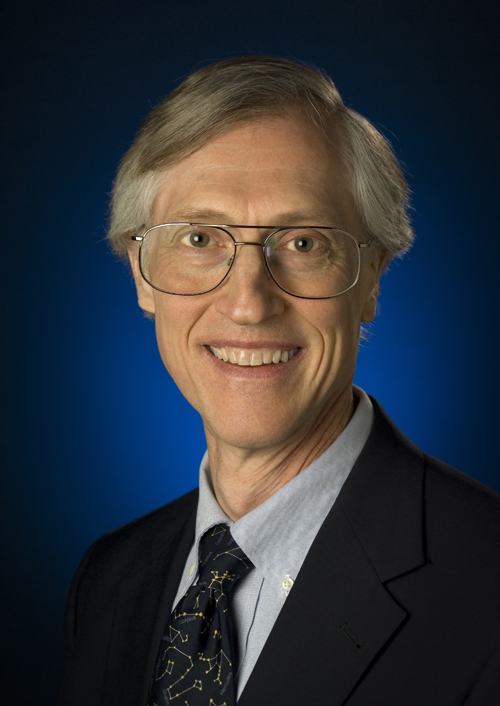Posted 9:37 p.m. Tuesday, Sept. 4, 2012

 [/caption]
Nobel Prize Winner in Physics John Mather will explain the history of the universe in a nutshell — from the Big Bang to now, and on to the future — during a public lecture at 5 p.m. Thursday, Sept. 13 at UW-La Crosse.
Mather, a senior astrophysicist at NASA's Goddard Space Flight Center, will tell the story of how humans got here, how the universe began, how it could have produced an Earth where sentient beings can live and how those beings are discovering their history.
“My impression is that the general public loves hearing about the meaning of life — It’s all very personal for us,” says Mather.
Mather has been interested in the story of how we got here since he was a young child growing up on a research farm where his father studied dairy cows. He was fascinated with science — particularly astronomy. This interest was fueled by the beginning of the space age. When Mather was still in grade school in the late 1950s, the Soviet Union successfully launched Sputnik 1, the world’s first artificial satellite. People with an interest in science had many opportunities to explore, he says.
He pursued astronomy and cosmology and became the Project Scientist for NASA’s Cosmic Background Explorer (COBE) satellite. The satellite measured the spectrum of the heat radiation from the Big Bang and discovered hot and cold spots in that radiation that are now believed to be the primordial seeds that led to the structure of the universe today. His team was able to confirm the Big Bang idea with extraordinary accuracy. It was for these Big Bang-related discoveries that Mather earned the Nobel Prize in Physics in 2006.
During his lecture, Mather will also explain Einstein’s biggest mistake, how Edwin Hubble discovered the expansion of the universe, how the COBE mission was built and how the COBE data support the Big Bang theory. He will also explain why “Big Bang” is a totally inadequate name for the expanding universe.
Mather, who now serves as Senior Project Scientist for the James Webb Space Telescope, will show NASA’s plans for this telescope, which is planned for launch in 2018. It will look even farther back in time than the Hubble Space Telescope, peering inside the dusty cocoons where stars and planets are being born today. It is capable of examining Earth-like planets around other stars using the transit technique, and future missions may find signs of life.
Mather’s visit includes a physics seminar, “Engineering Challenges and Scientific Capabilities of the James Webb Space Telescope” as well as visits with UW-L faculty, staff and students. He is the 13th Nobel Laureate in Physics to visit UW-L as part of a Distinguished Lecture Series in Physics.
"Ours is the only program in the state that offers students and the community the unique opportunity to hear and interact with Nobel Laureates each year,” says, Gubbi Sudhakaran, chair of UW-L’s Physics Department.
If you go:
What: Public lecture “History of the Universe from the Beginning to End”
When: Reception at 4:30 p.m. and lecture at 5 p.m. Thursday, Sept. 13
Where: Skogen Auditorium A, 1400 Centennial Hall, UW-L
If you go:
What: Physics seminar “Engineering Challenges and Scientific Capabilities of the James Webb Space Telescope”
When: Reception at 3 p.m. and lecture at 3:30 p.m. Friday, Sept. 14
Where: Skogen Auditorium A, 1400 Centennial Hall, UW-L
[/caption]
Nobel Prize Winner in Physics John Mather will explain the history of the universe in a nutshell — from the Big Bang to now, and on to the future — during a public lecture at 5 p.m. Thursday, Sept. 13 at UW-La Crosse.
Mather, a senior astrophysicist at NASA's Goddard Space Flight Center, will tell the story of how humans got here, how the universe began, how it could have produced an Earth where sentient beings can live and how those beings are discovering their history.
“My impression is that the general public loves hearing about the meaning of life — It’s all very personal for us,” says Mather.
Mather has been interested in the story of how we got here since he was a young child growing up on a research farm where his father studied dairy cows. He was fascinated with science — particularly astronomy. This interest was fueled by the beginning of the space age. When Mather was still in grade school in the late 1950s, the Soviet Union successfully launched Sputnik 1, the world’s first artificial satellite. People with an interest in science had many opportunities to explore, he says.
He pursued astronomy and cosmology and became the Project Scientist for NASA’s Cosmic Background Explorer (COBE) satellite. The satellite measured the spectrum of the heat radiation from the Big Bang and discovered hot and cold spots in that radiation that are now believed to be the primordial seeds that led to the structure of the universe today. His team was able to confirm the Big Bang idea with extraordinary accuracy. It was for these Big Bang-related discoveries that Mather earned the Nobel Prize in Physics in 2006.
During his lecture, Mather will also explain Einstein’s biggest mistake, how Edwin Hubble discovered the expansion of the universe, how the COBE mission was built and how the COBE data support the Big Bang theory. He will also explain why “Big Bang” is a totally inadequate name for the expanding universe.
Mather, who now serves as Senior Project Scientist for the James Webb Space Telescope, will show NASA’s plans for this telescope, which is planned for launch in 2018. It will look even farther back in time than the Hubble Space Telescope, peering inside the dusty cocoons where stars and planets are being born today. It is capable of examining Earth-like planets around other stars using the transit technique, and future missions may find signs of life.
Mather’s visit includes a physics seminar, “Engineering Challenges and Scientific Capabilities of the James Webb Space Telescope” as well as visits with UW-L faculty, staff and students. He is the 13th Nobel Laureate in Physics to visit UW-L as part of a Distinguished Lecture Series in Physics.
"Ours is the only program in the state that offers students and the community the unique opportunity to hear and interact with Nobel Laureates each year,” says, Gubbi Sudhakaran, chair of UW-L’s Physics Department.
If you go:
What: Public lecture “History of the Universe from the Beginning to End”
When: Reception at 4:30 p.m. and lecture at 5 p.m. Thursday, Sept. 13
Where: Skogen Auditorium A, 1400 Centennial Hall, UW-L
If you go:
What: Physics seminar “Engineering Challenges and Scientific Capabilities of the James Webb Space Telescope”
When: Reception at 3 p.m. and lecture at 3:30 p.m. Friday, Sept. 14
Where: Skogen Auditorium A, 1400 Centennial Hall, UW-L
